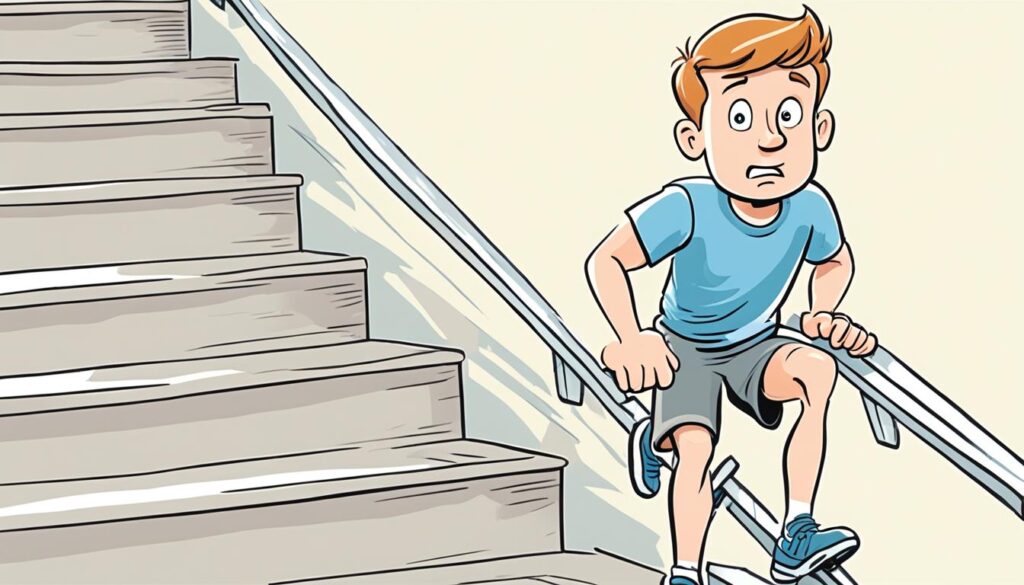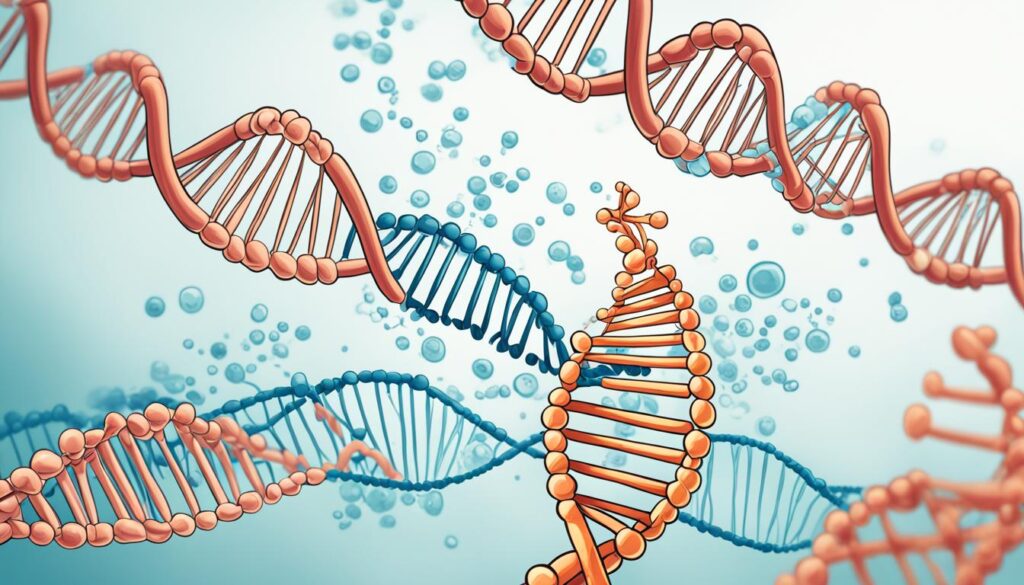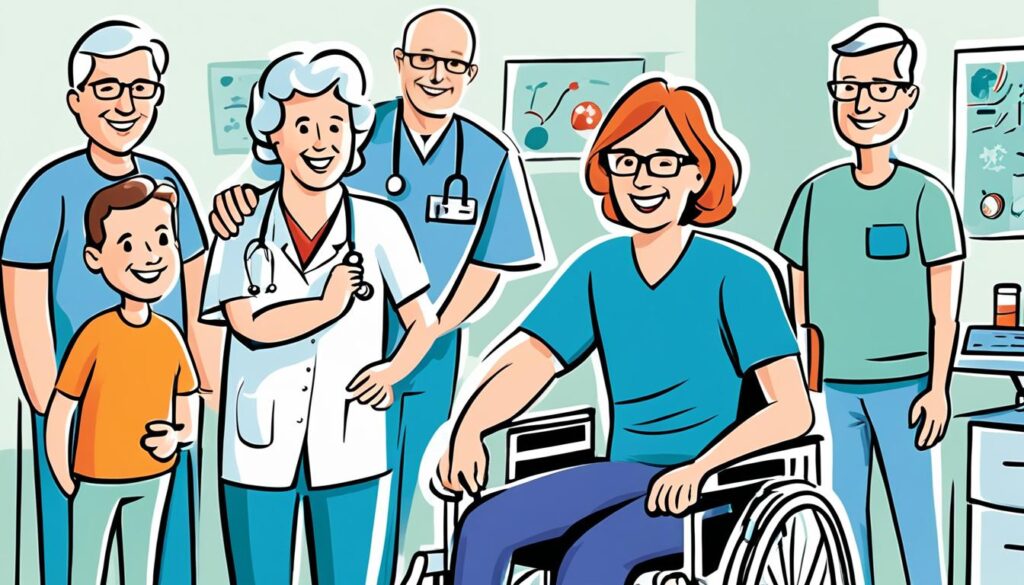Duchenne muscular dystrophy (DMD) is not common. It affects mostly young boys. They face issues with their muscles that get worse over time. This disease harms their heart and lung muscles too.
It is because of a changed dystrophin gene. This gene helps make a special protein for muscles. Missing this protein makes the muscles break down. Boys usually show signs when they are 2 or 3.
Normally, DMD is found in boys only. But, girls may also get it, though it’s rare. In Europe and North America, around 6 out of every 100,000 people have DMD.
Table of Contents
ToggleUnderstanding Duchenne Muscular Dystrophy
Duchenne muscular dystrophy (DMD) is a genetic disorder that weakens muscles. It’s one of four related conditions.
The others are Becker muscular dystrophy, an in-between form, and DMD-associated dilated cardiomyopathy.
Definition and Overview
Duchenne muscular dystrophy is a common hereditary disease. It affects about 2 in 10,000 people in the U.S.
This disease happens when a specific gene isn’t working right. This gene makes a protein called dystrophin that our muscles need.
Without enough dystrophin, our muscles can’t work well or fix themselves. This leads to muscle problems over time.
Prevalence and Affected Population
Worldwide, DMD affects about 6 in every 100,000 people. It mostly hits young boys. Around 1 in 3,600 baby boys are born with this each year.
Not long ago, boys with DMD didn’t live very long. But, better medical treatments have changed that. Now, they can live up to 30 years or more.
| Statistic | Value |
|---|---|
| Prevalence of DMD in Europe and North America | Approximately 6 per 100,000 individuals |
| Estimated incidence of DMD | 1 in 3600 male live-born infants |
| Prevalence of DMD in the United States | Approximately 2 per 10,000 individuals |
| Percentage of DMD cases due to new mutations | 30% |
| Percentage of carrier females affected by muscular weakness | 2.5% to 20% |
A woman who carries the faulty gene might not feel weak herself. But, 2.5% to 20% may have some muscle issues.
Also, many cases of DMD come from new mutations. They are not always inherited from a parent.
Duchenne muscular dystrophy Symptoms
The main symptom of Duchenne muscular dystrophy is muscle weakness. It can start when a child is 2 or 3. This weakness usually begins in muscles near the core of the body.
Then, it moves to muscles closer to the hands and feet.
Early Signs and Indicators
Early signs of DMD include issues with jumping and running. Boys might have a hard time walking and have a waddling walk. You might also notice their calf muscles getting bigger.
These signs can show up when they’re still toddlers.
Progression of Muscle Weakness
The muscle weakness in DMD keeps getting worse. It starts to affect more and more muscle groups. By school age, children with DMD may walk on their toes and have trouble using their arms.
Often, they end up using a wheelchair by age 12 as the disease progresses.
Impact on Respiratory and Cardiac Function
DMD also affects how the heart and lungs work. Those with DMD don’t usually live past their 20s. They might die from breathing problems or a weak heart. If not managed well, the effect on breathing and heart health can be very serious.

Causes and Genetic Factors
Duchenne muscular dystrophy (DMD) happens due to a gene mutation. This mutation affects the dystrophin protein, key for muscle function. Without it, muscles can’t work or heal well, leading to their weakness in DMD.
Role of Dystrophin Protein
The dystrophin protein is vital for muscle cell structure. It links parts inside the cell to its outer layer. But, if the gene for dystrophin is mutated, this connection fails, and muscles start breaking down.
X-Linked Inheritance Pattern
DMD is inherited in an X-linked recessive way, so the faulty gene sits on the X chromosome. Thus, males with a mutation develop DMD because they have one X chromosome. Females, with two Xs, can be carriers if the mutation is on one X. The other X might usually have a healthy copy.
In some families, DMD appears without a past history because mutations can start anew. Women carrying the gene have a 50% chance of passing it to their children. This means a 50% chance of their sons having Duchenne.

| Genetic Factor | Explanation |
|---|---|
| Dystrophin Protein | The dystrophin protein is vital for muscle cells’ health. But if its gene has a mutation, a non-working or missing protein leads to muscle problems. |
| X-Linked Inheritance | DMD’s inheritance pattern is X-linked recessive, placing the faulty gene on the X chromosome. Males with one mutation suffer from DMD. Females, having one healthy X, are often just carriers. |
| Spontaneous Mutations | One-third of DMD cases surprise families with no past record, due to new mutations. Carrier women have the same 50% risk of passing the mutation on to their children. |
Diagnosis and Testing
Diagnosing Duchenne muscular dystrophy (DMD) mixes physical checks with genetic tests. Doctors will look at the child’s muscle strength, flexibility, and reflexes. They also search for muscle wasting and big calf muscles.
Physical Examination
A doctor measures the child’s muscle use and growth. They watch how the child walks and stands from a sit. They also test other movement skills to spot early DMD signs. Doctors look for big calf muscles, a key DMD clue.
Genetic Testing and Analysis
Genetic tests pin down DMD and its specific gene issue. A muscle or blood sample is checked for mutations in the DMD gene. Around 70% to 80% of DMD cases have these mutations.
| Diagnostic Marker | DMD | BMD |
|---|---|---|
| Creatine Kinase (CK) Levels | They hit 10-20 times the limit by age 2, then drop 25% yearly | Elevated 5 times or more |
| Dystrophin Quantity | Less than 5% of normal | Usually more than DMD |
| Age of Onset | Starts in early years, usually age 2-3 | Can begin at 5-60 years, sometimes loss of walking later |
Exam and genetic test results combined give a DMD diagnosis. This diagnosis shows the exact genetic issues. Knowing this helps plan the best treatments.
Treatment and Disease Management
There’s no cure for Duchenne muscular dystrophy (DMD) yet. But, its treatment helps manage symptoms and improve life quality. Supportive care and therapies are key for DMD management.
Supportive Care and Therapies
Steroids like prednisone and deflazacort can boost muscle strength for 6 months to 2 years in DMD patients. Physical and occupational therapy, with assistive devices, improve life quality and length for those with DMD.
For a few, creatine supplements help make muscles stronger. In later DMD stages, eating and swallowing trouble might happen. This is called dysphagia. It needs special care.
Sometimes, surgery is needed for issues like scoliosis, or tight tendons. This can make life better for DMD patients by fixing serious muscle problems.
Emerging Treatments and Clinical Trials
Today, researchers look for new ways to treat Duchenne muscular dystrophy. They are testing “exon skipping” for DMD in the UK and the Netherlands. This might be a new duchenne muscular dystrophy treatment approach.
There are now more medicines to fight DMD. Duvyzat helps slow down the disease and makes moving easier. Medicines like Eteplirsen (Exondys 51) and Ataluren (Translarna) target specific types of DMD. These increase dystrophin, an important protein for muscle health.
Gene therapies are also in development, aiming for future FDA approvals. Many clinical trials are ongoing. They look for new ways to help people with muscular dystrophy.

Living with Duchenne Muscular Dystrophy
Living with Duchenne muscular dystrophy (DMD) includes many challenges. But with support and strategies, both the person and their family can enjoy life. It’s about managing the physical, emotional, and social parts of DMD well, to thrive.
Coping Strategies and Support
It’s important to have good ways to cope with DMD. Talking to other families dealing with the same issues can be a big help. This includes joining support groups both online and in person to feel less alone and to share advice.
And don’t forget about getting professional support like therapy. A counselor can help you and your family handle the tough feelings that may come up. They offer advice on dealing with stress and worry, and help you find ways to feel better.
Quality of Life Considerations
Focusing on a good life quality is crucial for those with DMD. You may need to adjust your living space, use tools that help, and maybe change how you learn or work. Adapting to new needs and limits over time is important.
Working with your healthcare team, teachers, and local groups is key. They can help you get the support and changes you need to live well. By standing up for what you require and being open to new ways of doing things, you can feel more independent and fulfilled.
| Coping Strategies | Quality of Life Considerations |
|---|---|
|
|
Conclusion
Even though Duchenne muscular dystrophy (DMD) is rare and hard to deal with, we’ve made great strides in its care. More is known about its causes. We have better ways to help. Plus, there are new treatments that give families hope for a better life. This isn’t the end of the fight. But, with more research and teamwork, things are looking up for those with Duchenne muscular dystrophy.
It’s important to keep learning about the latest treatments and getting support. This helps you face the challenges with strength. As we push forward, there is hope for better days. Together, we can make life better for those with Duchenne muscular dystrophy.
The search for a cure is ongoing. And the progress that’s been made is uplifting. There’s a strong drive to beat this disorder. Through awareness and working together, we aim for a future where this disease is less of a burden. There is hope for a better tomorrow for everyone touched by Duchenne muscular dystrophy.
FAQ
What is Duchenne muscular dystrophy (DMD)?
What are the primary symptoms of Duchenne muscular dystrophy (DMD)?
What causes Duchenne muscular dystrophy (DMD)?
How is Duchenne muscular dystrophy (DMD) diagnosed?
How is Duchenne muscular dystrophy (DMD) treated?
What is it like to live with Duchenne muscular dystrophy (DMD)?
Source Links
- https://www.ncbi.nlm.nih.gov/books/NBK482346/
- https://www.parentprojectmd.org/about-duchenne/what-is-duchenne/
- https://www.mda.org/disease/duchenne-muscular-dystrophy
- https://www.mda.org/disease/duchenne-muscular-dystrophy/signs-and-symptoms
- https://www.mayoclinic.org/diseases-conditions/muscular-dystrophy/symptoms-causes/syc-20375388
- https://www.parentprojectmd.org/about-duchenne/what-is-duchenne/genetic-causes/
- https://www.genome.gov/Genetic-Disorders/Duchenne-Muscular-Dystrophy
- https://www.mda.org/disease/duchenne-muscular-dystrophy/diagnosis
- https://www.nhs.uk/conditions/muscular-dystrophy/treatment/
- https://www.webmd.com/children/duchenne-muscular-dystrophy
- https://www.mayoclinic.org/diseases-conditions/muscular-dystrophy/diagnosis-treatment/drc-20375394
- https://duchenneandyou.com/living-with-duchenne/

Best Neurologist Doctor In Patna: Dr Chandril Chugh Dedicated to Your Well-being
Dr.Chandril Chugh is a neurologist who trained and practiced in the USA for more than a decade. He is compassionate and caring and is most well known for being a patient listener and spending ample time with patients.
